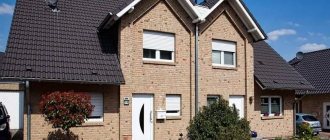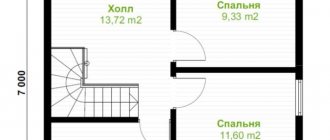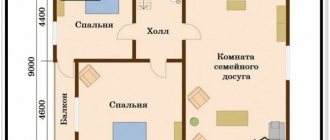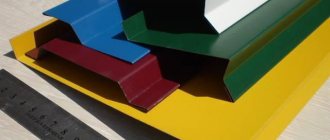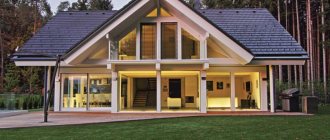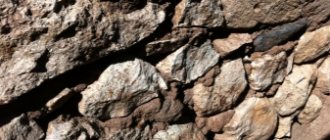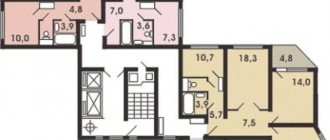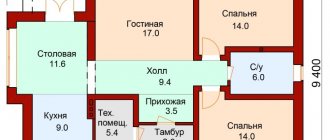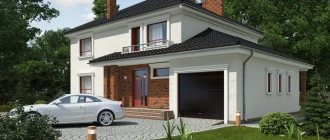Options for laying bricks around windows The best way to visually highlight openings on the facade of a house is to frame the windows with bricks. If desired, this can be done even if the walls of the house are built from concrete blocks, and even if they are brick, then, as they say: “God himself ordered it.” In addition, lining window openings with brick can be not only decorative, but also structural, since along with metal and concrete, brick is used to construct lintels over openings.
For an ignorant person, to do all this with your own hands, frankly speaking, is not easy. But for those who want to learn this, nothing is impossible. Get acquainted with the information presented below, watch the video in this article - and everything will work out for you.
Why are windows framed?
When erecting the walls of the designed building, all masonry work is carried out according to the drawings.
Surely, there will be no disproportions in such a structure, which cannot be said about houses that are built “by eye.” Those who are engaged in construction themselves should keep in mind that the appearance of the facade largely depends on the size and symmetry of the openings, and this is what you need to pay the main attention to
The role of openings in the aesthetics of the facade
The dimensions of windows, the width of the walls between them, the height of the window sill area - all this is regulated by standards. But even if the dimensions of the openings do not correspond to them, there is no big problem in this - any company today will manufacture window blocks according to individual sizes.
The key to the harmony of the facade is that the windows are located symmetrically on the walls and are themselves proportional. To understand what we are talking about, just look at the photo below. In our opinion, the shapes and sizes of the windows here are extremely poor, as well as their location on the wall, which is why the façade is not at all pleasing to the eye.
- In such situations, decorative lining of the opening with brick will only aggravate the dissonance, and the asymmetry will be even more striking. In any case, finishing of openings is carried out not during the process of laying the wall, but after it has already been completely raised to the designed height.
- It happens that the frame of the house was built earlier, and other work, including the design of brick window openings, is carried out after the house has settled. If this is exactly the situation you have, then before you begin this work, you need to check whether the window openings are located symmetrically in the brickwork.
All about the material, its advantages and types
Thanks to the use of facing bricks, the external defects of the building are hidden. If facade brick is used for old buildings, then it perfectly hides the presence of cracks on the walls of the house that appear due to load. But not only old houses require finishing - the brick facade of a new house looks even more impressive. Previously, many buildings were erected using brick, but now it is customary to use facing bricks specifically as a finishing element for the facade.
Facade bricks are:
Thanks to the use of facing bricks, external defects of the building are hidden
Both are used to decorate the exterior walls of the house and give it a beautiful appearance. The use of clinker is necessary for houses that are made using three-layer wall technology. Of course, the expenses for such a facade will be greater, but the benefits will also increase. A favorable microclimate is created inside houses with three-layer walls, and all thanks to the fact that the thermal insulation is distributed as evenly as possible between the load-bearing and outer walls.
The use of clinker bricks has a number of advantages:
- The material has high mechanical strength
- Frost-resistant and non-flammable, and also serves as a barrier to fire
- Not afraid of corrosion and pollution
- A huge selection of clinker facing material allows you to perform a variety of finishes, which allows you to make your house beautiful and attractive
Clinker brick facade
In addition to a large selection of shades, the facing material is also available in black and white. And if you take advantage of this and make the facade of your house from facing bricks of different colors, you can achieve incredible effects and show everyone that you have taste and imagination. The shapes of clinker bricks are varied; they can have rounded edges or chamfered edges. Clinker facing bricks can be perfectly combined with wood, stone and metal, so various combinations of clinker material and other facade elements will give an original appearance.
Nowadays it is customary to use facing bricks as a finishing element for the facade.
Repairing the brick façade is a major challenge. The cause of cracks on the wall can be not only time, but also shrinkage of the house or improper design. Sometimes it is possible to use overlays and metal belts - they strengthen the wall of the house and prevent further destruction.
Important! Outwardly, it can be difficult to understand whether a crack is growing or not. In order to understand this, glue a sheet of paper onto the damaged brick - if after time the sheet remains intact, then the crack does not increase and you can begin to carry out repair work and restoration
When it is impossible or you do not want to use such a finishing element as brick, you can use other options. For example, brick siding will be a cost-effective solution that you can implement yourself. Siding is lightweight, and thanks to this there is no unnecessary load on the house. Siding can be easily processed, and it is applicable for a curtain wall.
Brick siding panels: original and inexpensive facade design
Of all the advantages of using, the following can be highlighted:
- Brick siding is so similar to natural material that from afar it can be very difficult to understand whether a building is built of brick or lined with siding
- The ideal appearance is obtained by making a mold based on a cast of masonry from natural material
- A brick wall requires restoration, and facing siding just needs to be washed with water
- The service life of the finish reaches 30 years or even more - it is not afraid of precipitation and does not fade in the sun
- Light siding panels can be used to cover not only the walls of a house, but also its individual elements.
- A wide selection of colors, along with the lightness and low price of the panel, made it one of the most popular cladding elements
A hinged ventilated facade is used to cover the house with siding. The panels are fastened to the sheathing after the thermal insulation layer is laid. The ability to decorate your home yourself using such panels is a huge advantage. And the fact that this work is clean and dry, unlike “wet” facades, makes it even more pleasing and enticing to do it yourself.
Siding panels imitating brickwork
Framing options
Homeowners and professional builders use a variety of window framing options.
Wooden elements
Framing windows on the façade of a building using wooden elements is a very common option today. Their use allows you to decorate windows in a unique Russian style. This method of framing has come down to us since time immemorial and is still very popular.
The disadvantages of such finishing include significant cost, difficulty in manufacturing design elements in the same style, fragility of wood and high requirements for finishing care.
Related article: Window insulation using Swedish technology
Brick
Very convenient material to use. It is most often used in brick buildings, since in this case the framing of the windows of the house can be done directly at the construction stage.
Stone
Decorating window openings with stone is quite a labor-intensive job, which requires the use of a significant number of elements. They can be represented by cornices, platbands, keystones, carved brackets, window and door slopes made of stone, and window sills.
Decorating window openings with stone is quite a labor-intensive job, during which a significant number of elements should be used
Plaster stucco
This option for finishing windows on the facade of a building is very expensive not only in terms of cost, but also in terms of labor intensity at the stage of installation work. In recent years, the popularity of gypsum stucco has declined significantly. It has been replaced by modern and more affordable materials.
Plastic profile panels
A very affordable option in terms of price and installation for finishing windows on a facade made of various materials, including brick, wood and others. The only, but quite noticeable, disadvantage of using profile panels is the low decorative effect of the resulting cladding.
Plastic profile panels are a very affordable option for finishing windows on the facade in terms of price and installation.
Wood-polymer composite
Recently, this material has received close attention. Its undoubted advantages are low cost, simple installation and guaranteed durability.
Steel corner as a “hidden” jumper
Question asked:
Grigorash
In connection with the use of facing bricks, the question naturally arose about covering window and door openings so that the appearance of lintels would not spoil the cladding. Builders recommend using a corner, but opinions differ regarding its size. So what corner should be used for “secret” lintels for openings with a width of 700 mm, 900 mm, 1200 mm, 2200 mm, and one opening 3000 mm? There is a corner 75x75x7 and 80x80x8 available, is it possible to use it?
Material selection
First of all, you need to decide on the material that you want to use for finishing. Very often, in brick houses, windows are also framed with brick of the same or a different color. It’s not difficult to make simple brickwork, and this option will always look simple and stylish. The material is easy to use, beautiful and durable. Framing can be done both during the construction of your home and after its completion.
For a brick house, you can also use stonework around the windows. The decor of window frames with facing stones can be very diverse - sometimes the stone is laid evenly on the frame, and sometimes an interesting design or mosaic is created from several types of stones.
Metal framing looks interesting and is suitable for both modern and traditional home designs. The design of such structures can be extremely diverse. The advantage is their durability, but you need to remember that the metal quickly heats up in the sun and becomes extremely cold in the cold - in some cases this can cause discomfort.
Framing with wood is typical for both brick and wooden houses. You can make both laconic frames and carved versions in the Russian style. At the same time, it is very important to properly treat the wood from moisture and contamination so that the frame really lasts you a long time.
Concrete structures are also quite simple. Concrete can look quite interesting if the structures are covered with plaster and paint. This option looks good in a house with a painted facade, and it is most convenient to make such window framing during the construction stage.
For houses in a classic style, moldings with a wide variety of designs are often used. They are usually made from polyurethane. The molding is usually a white structure that imitates columns or stucco: this option can look very elegant, but it will only be appropriate if the design of the entire house is appropriate.
If you want to save money, you can use siding, plastic structures and even foam. If you choose an artificial material, you need to carefully consider its quality. The advantage is that from artificial materials you can create quite a few options for unusual design framing - this solution is suitable for modern cottages and country-style houses.
General information
The construction industry is developing very rapidly, and the market for construction and finishing materials is regularly replenished with new high-tech materials, which allow expanding the field of activity of designers and architects.
New and modern finishing materials make it possible to make the framing of your home's windows stylish, original, attractive and durable. For decorative window framing, materials such as brick, natural stone, gypsum, polyurethane panels, wood and other materials can be successfully used. Most often you can see the framing of openings on the facade with brick and wood.
The choice of material directly depends on the goals that the home owner achieves. In addition, it should be remembered that framing with brick, wood, polyurethane slabs and other materials allows you to create an original style of window framing.
For decorative framing of windows, materials such as brick, natural stone, gypsum, wood and other materials can be successfully used.
The nuances of facing a house with bricks
Finishing the facade with brick has features that must be taken into account to obtain a high-quality result.
Strengthening the foundation
If you intend to cover a structure that was erected quite a long time ago or is a frame structure, then it is necessary to obtain reliable and durable support for the cladding layer. The fact is that the brick puts a serious load on the building itself and on the area where it is located. In the absence of a strong base, the surface will sag and become deformed. To strengthen the foundation, a solution in the form of a reinforced tape is additionally poured over the entire area of the house.
If there is no space for external brickwork on the main foundation, then it is necessary to install a reinforced concrete frame nearby
Bunch
The lining needs to be securely connected to the main walls; for this purpose, metal mesh, anchors or wire are used. The bottom line is that there must be at least 4 points per 1 m2. The selected material is installed in load-bearing walls and located along the seams of the masonry, while the minimum depth should not be less than 8–9 cm.
When arranging decorative masonry during the construction of walls, the tie is carried out using a mesh; for finished buildings, anchors are used
Creating window openings
Window openings in brickwork require a very responsible approach. To install them, it is necessary to carry out markings in advance and draw up a layout diagram. That is why most often surfaces are covered in parallel with the construction of load-bearing structures. The laying of window openings is carried out as follows:
- Initially, the main part of the walls is erected according to the chosen method.
- The creation of the opening begins as soon as the height of the areas located nearby is equal to the height of the window. The main thing is to make sure that all openings have a uniform structure.
- The masonry is carried out using the end method; for this purpose, the brick is cut to length. First, the lower section of the opening is laid out, and then the vertical posts.
- The upper part needs strengthening. For this purpose, a metal corner of suitable thickness, treated with a protective anti-corrosion solution, is used.
- The corner is located exactly above the window; one of the corners of the brick is cut off. First, the elements are placed without mortar to ensure the accuracy of their location, and then they are mounted on the composition. The masonry can be made protruding or flush with the main walls. To avoid deformation, the corner is propped up with a wooden strip.
- If it is planned to line the opening without removing it, then the bricks are laid close to the frame with the elements trimmed to the required size.
Of course, if you lack experience, window design may require more time and effort, but the main thing is to install the parts exactly to the level. Doorways are created using a similar principle.
In the absence of experience, it is advisable to check each level of masonry with a template
How to make a window hole during masonry?
The construction process should not compromise the level of strength in masonry walls. The installation of window openings involves installing a base in the upper part. For this purpose, purlins are used - supporting elements made of durable materials. This base is attached to the walls. Purlins increase the resistance of the structure to mechanical loads. There are several ways to lay the base:
- Channel is a linear profile made of metal. The size of the lintel is selected taking into account building codes and regulations. Such a run reliably strengthens the structure. The main disadvantage is inconvenient installation. The length of each metal element must exceed the width of the opening by at least 30 cm.
- Corners are L-shaped metal jumpers. This type of base can be installed quickly. Disadvantage: cannot be used for wide windows. Metal purlins must be coated with a protective agent.
- You can make concrete lintels yourself or purchase a blank. In the second case, the finished element is mounted, immediately continuing the laying. Purlins strengthen the structure and are suitable for windows of different widths. The disadvantage is the heavy weight of the product.
Installation algorithm in an already finished wall
The second option for arranging a window opening involves performing work on an existing wall. The workflow looks like this:
- First the marking is done. This stage involves identifying zones for placing jumpers and technological holes. The working stage is carried out using the triangle method, the lintel is marked so that its top is in the lower masonry row;
- Having made such marks, fifteen centimeters are added for each edge of the jumper. This distance is necessary to install supports that secure the lintel made of metal structures or reinforced concrete;
- installation of the support begins. It is necessary to provide a distance of seventy to eighty centimeters between the load-bearing wall and the supporting element;
- as soon as the support is placed, a wooden beam is laid on it, which is necessary to redistribute the load effects;
- a mark is made along the outer surface of the wall corresponding to the placement of the beams;
- in order to place these marks on the inside of the wall, drill holes into which studs are installed, supporting them on each side with supporting elements;
- the next stage is fixing the support. This can be done with ordinary nails, driving them into boards and studs;
- Using a hammer and a sharp chisel, the plaster layer is removed from the surface of the wall. The cleared area should correspond to the size of the future window opening. An additional three centimeters are added on each side;
- Having removed the plaster material, we begin dismantling the brickwork section. It is best to move from the place where the jumper is located, after that all that remains is to install it;
- all protruding bricks are adjusted;
- Having finished installing the jumper, use a grinder to make a cut. This will help to level the edges of the brickwork of the opening area, remove irregularities above the window, and facilitate subsequent processing of the slopes;
- At this stage, the design is completed, it is allowed to proceed with the installation of the window structure.
Peculiarities
Exterior window framing is a process that must be approached carefully. Framing is preceded by the installation of the windows themselves - wooden or plastic. If you have never encountered this, it is better to seek help from professionals
It is especially important that the work is carried out by specialists if you have a ventilated facade
Once the windows are installed, you can think about the exterior decor and take into account several nuances.
Modern finishing options are extremely diverse
At the same time, when choosing synthetic options, make sure that the material does not have any foreign odor when heated and does not deform - the quality of the material is important for your health and comfort
Before installing frames made of stone or other heavy materials on the facade of the house, calculate whether the weight of the structure is too large
In rare cases, particularly heavy structures lead to deformation of the walls. Pay attention to the rules for working with different materials and think about whether you will do the finishing yourself. While siding can be easily fixed with your own hands, stone framing will require special knowledge, and the work of specialists can be expensive. Consider what style of framing will suit your home
The finishing should be organically combined with both the exterior of the house and the decorative elements on your site.
Cladding methods
Varieties of finishing design
Laying window openings from facing bricks will not cause any particular difficulties if you initially plan everything correctly, use high-quality tools and materials, and maintain proportions and symmetry.
There are the following methods for lining window openings with brick:
- Chernova. It is used when masonry is carried out by an inexperienced worker, when using stones from an uneven surface or creating a complex figure with gaps. Once the solution has hardened, the structure is finished using decorative plaster.
- Finishing. Assumes precise work with high quality materials. The masonry is carried out with millimeter precision; no additional finishing is required upon completion.
The choice of method is determined by your own abilities and the configuration of the purchased brick.
What do you need to know?
The design of the window determines the operational purpose of the room. Sunlight enters the room through the window, but there are no barriers to cold and high humidity.
If the installation is carried out incorrectly, dampness and mold will quickly appear in the room.
When preparing window openings, pay attention to the material from which the walls are built. For a brick stone or concrete block, the element is made according to the same parameters, but for a log house there are different standards.
The current restrictions on opening areas for windows are practically not taken into account by developers of private housing. As a rule, owners determine the shapes and parameters of windows based on their own wishes. This leads to a situation where the finished window turns out to be very small or excessively large, which is accompanied by warping of the frame structures, loose fitting of the sashes, and the appearance of condensation inside.
It is most correct when the opening area for the window appears during the process of removing the masonry. This will ensure:
- correct installation of the frame;
- reliable fastening of the entire window structure;
- sealing;
- moisture removal;
- isolation from extraneous noise;
- decoration of facade walls.
The frame should fit easily into the opening intended for installing a window. Window sills inside and outside are secured with a thin layer of mortar; a niche is provided for cladding.
Most often, PVC window blocks are installed. It follows that it is reasonable to define such products to standard sizes, and it is easy to adjust the masonry of the window opening from facing bricks to the intended design.
If you decide to order windows for existing openings that do not meet established standards, an individual order will cost you much more.
In the existing GOST there is a concept - a quarter for a window opening and its presence is mandatory. It represents a protrusion on the outer part of the wall, made according to certain dimensions.
The provided quarter will cover the gap area created by the wall and window frame from the outside and will hide the insulation used during installation. The window will be reliably protected from blowing and moisture penetration, and the structure will be attractive.
Homemade run
When designing window openings of non-standard sizes, the production of the lintel (its filling) is carried out at the location. To do this you will need to perform the following typical operations:
- first of all, the masonry surfaces on the sides of the window opening are cleaned of mortar residues;
- after this they are thoroughly primed;
- At the final stage of work, formwork is installed at the location of the lintel.
Formwork
Reinforcement
Upon completion of these procedures, a thin layer of pre-prepared concrete mixture is poured into the formwork, after which a reinforcing mesh is immediately placed there. After this, you can continue pouring the lintel, followed by placing another reinforcing fill in the concrete. When dismantling the formwork, it should be taken into account that it is not always possible to dismantle its lower part.
Supports for formwork
Lintel laying
When decorating window openings lined with facing bricks (the so-called facing brickwork), in order to preserve its decorative advantages, it is allowed to use channels (wide metal corners). In this case, the visible part of the purlin will be located only on the inside of the load-bearing wall.
Laying a figured window opening
At the same time, there should not be any noticeable traces of the presence of a lintel on its façade surface.
Types of brick covering openings
A lintel is the covering of a door or window opening. Reinforced concrete lintels are most widely used in construction. They can span long spans and withstand heavy loads.
Brick lintels are used only for non-load-bearing walls, as they do not have sufficient strength for this. The span width should not exceed 1.7 m.
1 - private; 2 - wedge-shaped; 3 - arched; 4 - arched beam
Ordinary brick lintels are called ordinary lintels. The bricks in them are supported by reinforcement. Wedge, bow, lancet, arched, semicircular and box lintels are used as an architectural detail of facades.
1 - semicircular; 2 - lancet; 3 - box
Their variety is determined by the shape of the opening, or more precisely, the outline of its upper part. According to the principle of an arched lintel, vaults are laid out, which are the ceiling of buildings.
Before the invention of concrete (late 19th century), openings were covered with brick lintels. It was not only a tribute to beauty. Wedge and types of arched openings held the load from the wall due to the expansion, which ensured the fan arrangement of the bricks in the masonry.
In temple architecture, arches and vaults, as a way of covering openings and rooms, over time became the canon of church architecture. Modern brick arched openings and vaulted ceilings are only an architectural solution.
Style and design
It is very important that the design of the entire house looks like a single whole. For a harmonious style, not only the material is important - the color design is also of great importance, as well as the design itself
Depending on your preferred materials, consider tips for stylish exterior window treatments.
Very often, for the facades of houses in the Russian style, windows are framed from wood with traditional floral patterns. At the same time, more modern options can also look great: you can create a wooden frame with an asymmetrical streamlined shape, or make a strict geometric pattern on it. It will look very good to add a second wooden element of a different color - for example, light wood can be combined with wenge or red wood decor.
Stonework can be very diverse. Sometimes neat identical stones are used to lay out an even frame around the window in the same way as with bricks. Nevertheless, the material allows you to try more interesting designs. For example, you can make masonry that smoothly transitions into the masonry of a facade of a different color if your house is entirely trimmed with stone. You can use two or three stones to frame one window. Contrasting colors such as black and white can look good, or, on the contrary, options that are similar in tone: for example, shades of beige, brown and terracotta.
Often frames made of artificial materials also highlight windows in an interesting way. You can choose an unusual siding color or make a plastic structure of an interesting shape.
Facade system Koner
Clamps for horizontal masonry
Horizontal jumper. The simplest type of masonry for lintels is horizontal masonry. It is no different from the rest of the facade. The main condition is that the brick of the first row must be solid. Fulfillment of this condition will ensure the beauty and completeness of the lintel from all sides, both from the facade and from below. When installing a horizontal lintel, clamps SKhG-50-40/50 and SKhP-50-45/65 are used in combination with masonry mesh KS-3. Horizontal jumper installation diagram.
Openings over 2 meters are calculated individually, since for the construction of such openings suspended consoles with different projections from the wall are used.
Clamps for vertical masonry
Vertical jumper. The most common type of lintel masonry is vertical masonry. In this case, the brick can be either solid or hollow. Sometimes, to achieve greater effect, the first 2 rows of masonry above the opening are made vertically. The combination of horizontal and vertical façade masonry is one of the favorite architectural techniques. Often, laying lintels in one, two or three rows serves as the beginning of an entire belt of vertical masonry. A variation of vertical masonry is the laying of a lintel of one and a half bricks. Alternating horizontal seams in the lintel creates an interesting, memorable pattern. When installing a vertical lintel, clamps SKhV-50-165/10 and SKhP-50-45/65 are used in combination with masonry mesh KS-3. Vertical jumper installation diagram.
Openings over 2 meters are calculated individually, since for the construction of such openings suspended consoles with different projections from the wall are used.
Clamps for laying on the edge inside
This type of lintel allows you to solve several issues: hide the insulation and make more beautiful brick-thick slopes. It is also possible to push the brick forward around the opening and add volume to the frame. When installing a lintel with masonry on an edge, clamps SKhP-50-65/155 and SKhP-50-45/65 are used in combination with masonry mesh KS-3. Longitudinal reinforcement with KS-3 reinforcing mesh is used under the action of horizontal and vertical loads, as well as in structures subject to seismic influences. Reinforcement of stone structures significantly increases their load-bearing capacity and solidity, and ensures the joint operation of individual parts of buildings. Such reinforcement is necessary in the outer layers of multilayer wall structures, since they are primarily exposed to atmospheric influences, wind loads and temperature changes. Scheme of mounting the jumper on the edge inside.
Openings over 2 meters are calculated individually, since for the construction of such openings suspended consoles with different projections from the wall are used.
Clamps for combined masonry
Combined masonry allows you to combine all the advantages of the previous two types of lintels. When installing lintels with combined masonry, clamps SKhK-50-185/155 and SKhP-50-45/65 are used in combination with masonry mesh KS-3. Installation diagram of a combined jumper.
Openings over 2 meters are calculated individually, since for the construction of such openings suspended consoles with different projections from the wall are used.
Peculiarities
Exterior window framing is a process that must be approached carefully. Framing is preceded by the installation of the windows themselves - wooden or plastic. If you have never encountered this, it is better to seek help from professionals
It is especially important that the work is carried out by specialists if you have a ventilated facade
Once the windows are installed, you can think about the exterior decor and take into account several nuances.
Modern finishing options are extremely diverse
At the same time, when choosing synthetic options, make sure that the material does not have any foreign odor when heated and does not deform - the quality of the material is important for your health and comfort
Before installing frames made of stone or other heavy materials on the facade of the house, calculate whether the weight of the structure is too large
In rare cases, particularly heavy structures lead to deformation of the walls. Pay attention to the rules for working with different materials and think about whether you will do the finishing yourself. While siding can be easily fixed with your own hands, stone framing will require special knowledge, and the work of specialists can be expensive. Consider what style of framing will suit your home
The finishing should be organically combined with both the exterior of the house and the decorative elements on your site.
Brief conclusion
When installing additional windows to improve air circulation or as a new light source, do not forget to be careful. The window area is decorated during the construction of the house. It is allowed to make holes in the finished wall. The opening can be lined with brick in different ways. It is important to properly strengthen the structure without disturbing the balance of load distribution on the load-bearing elements. In addition, the process of installing window openings should not compromise technical safety. It is important that construction work is combined with the standards of the utility systems located in the house.
Cladding brick windows
It emphasizes the contour, adds volume and highlights the windows on the façade of the building. Cladding a window with contrasting or relief brick allows you to almost completely change the facade. Facing brick gives the building a more neat and elegant look.
The surroundings of the windows must be carefully calculated and symmetrical in relation to the masonry of the main walls and the corners of the building. Original, beautiful windows will complete the look of the facade, provided that the cracks are carefully sealed using special masonry or using brick platbands.
The harmonious appearance of the facade directly depends on the size and shape of the windows, or more precisely, on how symmetrical they are relative to the corners of the building and the width of the partitions. It is necessary to comply with certain standards when constructing the walls of buildings, but in practice it is often possible to observe inconsistencies that it is advisable to eliminate before laying facing bricks.
Window frame made of polyurethane - advantages
The first (main) advantage is the original design.
Almost no other material for decorative framing of windows and doors has such variability and the ability to combine various components. Here you can create compositions from moldings and cornices, arches and rustications, rosettes, consoles and keystones; you can “play” with the length of elements, the distances between them, patterns of alternation, color and style.
The ability to cut any decorative elements in any place and at any angle without compromising quality, easy assembly of stucco molding allows you to create individual compositions from finished elements or their parts. For greater expressiveness, you can use individual stucco details with small patterns - bas-reliefs, rosettes, panels, door trims. The result is a truly exclusive frame for a door or window, one of a kind, since the designer’s imagination is limited solely by the size of the opening and the financial capabilities of the customer.
Related article: Do-it-yourself repair of plastic swing windows
The second advantage is the durability of polyurethane stucco molding and its ability to hold its shape even for small artistic detailing.
Indeed, the ease of care and durability of polyurethane products can hardly be overestimated. Facade decor made from it is not afraid of snow, rain, or frost; it can be washed with both ordinary water and detergents. Frames of windows and doors made of polyurethane on the facade of the house do not need to be restored, like wooden decor - it is enough to paint it and it will look like new. As for durability, the service life of polyurethane stucco is comparable to the service life of a building - more than 25 years.
The third advantage is ease of installation.
As you know, polyurethane stucco is very easy to process. It can be sawed, cut, drilled, and glued. Therefore, the installation of frames for openings is greatly simplified. Elements - door and window frames, sandstones, rusticated stones and so on can be put together almost like a mosaic; they just need to be fastened together and fixed to the load-bearing surface with glue and self-tapping screws: the decor will hold firmly.
Another advantage is the lightness of polyurethane stucco.
Due to its low weight, it can be attached to any flat surface, including plastered walls and houses of lightweight construction (for example, those made using frame technology). Stucco molding is also convenient to work with: even large decorative trims and moldings can be lifted by installers without the use of special equipment, and this is a direct reduction in the costs of construction work. Our website presents original architectural solutions for decorative framing of windows and doors with polyurethane stucco, developed by the FACADE PROJECT company.
Ways to seal an opening above a door
Making repairs with your own hands is doubly pleasant. After all, this allows you to enjoy the process and gives you the opportunity to really get what you want. And independent actions are an opportunity to save money. As a result, this approach is very popular among us, but many suffer from it. After all, any repair involves certain difficulties that have to be overcome. And very often unforeseen circumstances or unusual situations arise. For example, there is a space above the door that needs to be filled. What is the best way to do this? What tools and materials should I use? How to properly lay the opening above the door?
Let's try to answer all these questions, using photos for clarity.
Tips for working with the material
Strength, durability and visual attractiveness of a brick facade can only be achieved by working in strict accordance with existing technologies:
Brick cladding is always a ventilated facade. It is better to use “breathable” mineral wool as insulation (if necessary). The use of polyurethane foam and polystyrene foam sheets is impractical, since in this case they cannot be avoided becoming damp, which means the materials will lose their thermal insulation properties. Their use is permissible only if there is no ventilation gap between the facade and the walls.
- The service life of mineral wool insulation can be increased by using a moisture-proof, vapor-permeable membrane.
- Brick cladding, especially a combined facade (when different materials are used for the walls and the façade) requires mandatory connection with load-bearing walls. Outdated “old-fashioned” methods of connection (reinforcement, steel mesh and other improvised materials) usually cause cracking of the facade in the area of connection.
- If it is necessary to cut brick, the only tool that will allow you to make an even cut without destroying the material is a grinder with a disk for cutting dry stone with a diameter of 230 mm.
- Before laying the facade, load-bearing walls must be cleaned, dried and coated with at least two layers of primer, and wooden buildings require additional treatment with antiseptics and fire retardants.
- Using products from several batches at once will help to avoid the effect of a striped facade, the appearance of which is due to differences in brick shades. To do this, you should take 3-5 pallets with bricks from different batches and use them alternately when laying rows.
- When using not special masonry mixtures, but self-made cement mortar, the bricks are soaked in water for several minutes before laying. This is done to prevent the material from taking moisture from the solution.
It is important to make vertical ventilation gaps every 3 rows of cladding. They are not filled with solution; when it gets there, it is immediately removed with a wooden stick.
You can also create ventilation gaps using plastic boxes. Their width is 10 mm, and their height corresponds to the height of the brick. Their use is much more convenient, especially since the boxes are inexpensive. At least 2 ventilation gaps must remain in the lower part of the windows when facing.
Tying the exterior trim to the main wall
Without proper attachment of the finishing layer to the wall, rapid destruction of the structure, displacement of its elements, and cracks are possible. There are dozens of ways to tie designs together. If there are no rods, plaster mesh and other elements intended for tying, then fastening is carried out using dowels and flexible wire (knitting). A dowel with a diameter of 6 mm is driven into the wall, and a wire fastener is screwed to its head, the length being equal to the width of the brick. The ends of the wire are hidden inside the masonry. A high-quality binding is a wire fastening every four rows. In width - every 60-70 cm.
